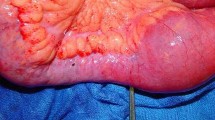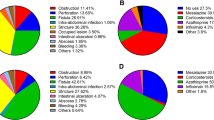Abstract
Background
Surgery is common in patients with Crohn’s disease and can contribute significantly to patient morbidity. The National Surgical Quality Improvement Program surgical risk calculator (NSQIP-SRC) that is currently utilized to predict surgical risk does not take Crohn’s disease into account and, as a result, seems to underestimate risk in this patient population. This study aimed to evaluate the accuracy of the NSQIP-SRC in Crohn’s disease patients and to evaluate the utility of disease severity scores in predicting surgical risk.
Methods
Between 2011 and 2017, there were 176 surgical cases involving Crohn’s disease patients. Demographic data and 30-day surgical outcomes were collected. Disease severity scores including Harvey Bradshaw Index (HBI), Crohn’s Disease Activity Index (CDAI), Simple Endoscopic Score for Crohn’s Disease (SES-CD), and NSQIP-SRC risk percentages were calculated.
Results
Patients in remission based on HBI had a complication rate of 8.57% (n = 3), while those with mild or moderate-severe disease had rates of 33.33% (n = 11) and 38.46% (n = 20) respectively (p = 0.0045). In multivariable analysis, those with mild (OR; 8.37, 95% CI; 1.64, 42.78; p = 0.011) or moderate-severe (OR; 11.69, 95% CI; 2.42, 56.46; p = 0.002) disease had increased odds of complication compared to remission. Complication rate was not associated with NSQIP-SRC percent risk of any complication.
Conclusion
NSQIP-SRC does not accurately predict risk in patients with CD undergoing surgery. Higher disease activity based on HBI is associated with increased odds of complication and may prove to be more predictive of surgical complication in the Crohn’s patient population.



Similar content being viewed by others
References
Cheifetz AS. Management of active crohn disease. JAMA. 2013;309(20):2150–2158.
Dahlhamer JM, Zammitti EP, Ward BW, Wheaton AG, Croft JB. Prevalence of inflammatory bowel disease among adults aged ≥18 years — united states, 2015. . MMWR Morb Mortal Wkly Rep. 2016;65:1169.
Molodecky NA, Soon IS, Rabi DM, et al. Increasing incidence and prevalence of the inflammatory bowel diseases with time, based on systematic review. Gastroenterology. 2012;142(1):54.e42. http://www.sciencedirect.com.proxy.lib.ohio-state.edu/science/article/pii/S0016508511013783. doi://doi-org.proxy.lib.ohio-state.edu/10.1053/j.gastro.2011.10.001.
Bouguen G, Peyrin-Biroulet L. Surgery for adult crohn’s disease: What is the actual risk? Gut. 2011;60(9):1178–1181. https://doi.org/10.1136/gut.2010.234617.
Ma C, Moran GW, Benchimol EI, et al. Surgical rates for crohn’s disease are decreasing: A population-based time trend analysis and validation study. Am J Gastroenterol. 2017;112(12):1840–1848.
Buisson A, Chevaux JB, Allen PB, Bommelaer G, Peyrin-Biroulet L. Review article: The natural history of postoperative crohn’s disease recurrence. Aliment Pharmacol Ther. 2012;35(6):625–633. https://doi.org/10.1111/j.1365-2036.2012.05002.x.
Bilimoria KY, Liu Y, Paruch JL, et al. Development and evaluation of the universal ACS NSQIP surgical risk calculator: A Decision aid and informed consent tool for patients and surgeons. J Am Coll Surg. 2013;217(5):842.e3. http://www.sciencedirect.com/science/article/pii/S1072751513008946. 10.1016/j.jamcollsurg.2013.07.385.
Cohen ME, Liu Y, Ko CY, Hall BL. An examination of american college of surgeons NSQIP surgical risk calculator accuracy. J Am Coll Surg. 2017;224(5):795.e1. http://www.sciencedirect.com/science/article/pii/S1072751517301540. https://doi.org/10.1016/j.jamcollsurg.2016.12.057.
Keller DS, Cologne KG, Senagore AJ, Haas EM. Does one score fit all? measuring risk in ulcerative colitis. Am J Surg. 2016;212(3):433–439. https://doi.org/10.1016/j.amjsurg.2015.10.033.
Prasad KG, Nelson BG, Deig CR, Schneider AL, Moore MG. ACS NSQIP risk calculator: An accurate predictor of complications in major head and neck surgery? Otolaryngol Head Neck Surg. 2016;155(5):740–742. https://doi.org/10.1177/0194599816655976.10.1177/0194599816655976.
Rivard C, Nahum R, Slagle E, Duininck M, Isaksson Vogel R, Teoh D. Evaluation of the performance of the ACS NSQIP surgical risk calculator in gynecologic oncology patients undergoing laparotomy. Gynecol Oncol. 2016;141(2):281–286.
Edelstein AI, Kwasny MJ, Suleiman LI, et al. Can the american college of surgeons risk calculator predict 30-day complications after knee and hip arthroplasty? J Arthroplasty. 2015;30(9 Suppl):5–10. https://doi.org/10.1016/j.arth.2015.01.057.
O’Neill AC, Bagher S, Barandun M, Hofer SOP, Zhong T. Can the american college of surgeons NSQIP surgical risk calculator identify patients at risk of complications following microsurgical breast reconstruction? Journal of Plastic, Reconstructive & Aesthetic Surgery. 2016;69(10):1356–1362. http://www.sciencedirect.com/science/article/pii/S1748681516300961. 10.1016/j.bjps.2016.05.021.
Arce K, Moore EJ, Lohse CM, Reiland MD, Yetzer JG, Ettinger KS. The american college of surgeons national surgical quality improvement program surgical risk calculator does not accurately predict risk of 30-day complications among patients undergoing microvascular head and neck reconstruction. Journal of Oral and Maxillofacial Surgery. 2016;74(9):1850–1858. http://www.sciencedirect.com/science/article/pii/S0278239116002421. https://doi.org/10.1016/j.joms.2016.02.024.
Massoumi RL, Trevino CM, Webb TP. Postoperative complications of laparoscopic cholecystectomy for acute cholecystitis: A comparison to the ACS-NSQIP risk calculator and the tokyo guidelines. World J Surg. 2017;41(4):935–939. https://doi.org/10.1007/s00268-016-3816-3.
Mitchell TO, Holihan JL, Askenasy EP, et al. Do risk calculators accurately predict surgical site occurrences? J Surg Res. 2016;203(1):56–63. http://www.sciencedirect.com/science/article/pii/S0022480416001347. https://doi.org/10.1016/j.jss.2016.03.040.
Cusworth BM, Krasnick BA, Nywening TM, et al. Whipple-specific complications result in prolonged length of stay not accounted for in ACS-NSQIP surgical risk calculator. HPB (Oxford). 2017;19(2):147–153.
Teoh D, Halloway RN, Heim J, Vogel RI, Rivard C. Evaluation of the american college of surgeons national surgical quality improvement program surgical risk calculator in gynecologic oncology patients undergoing minimally invasive surgery. J Minim Invasive Gynecol. 2017;24(1):48–54.
Samson P, Robinson CG, Bradley J, et al. The national surgical quality improvement program risk calculator does not adequately stratify risk for patients with clinical stage I non-small cell lung cancer. J Thorac Cardiovasc Surg. 2016;151(3):705.e1.
Adegboyega TO, Borgert AJ, Lambert PJ, Jarman BT. Applying the national surgical quality improvement program risk calculator to patients undergoing colorectal surgery: Theory vs reality. The American Journal of Surgery. 2017;213(1):30–35. http://www.sciencedirect.com/science/article/pii/S0002961016302938. https://doi.org/10.1016/j.amjsurg.2016.04.011.
Mogal HD, Fino N, Clark C, Shen P. Comparison of observed to predicted outcomes using the ACS NSQIP risk calculator in patients undergoing pancreaticoduodenectomy. J Surg Oncol. 2016;114(2):157–162. https://doi.org/10.1002/jso.24276.
Hu W, Chen H, Lee K, et al. Assessment of the addition of hypoalbuminemia to ACS-NSQIP surgical risk calculator in colorectal cancer. Medicine. 2016;95(10):e2999. https://www.ncbi.nlm.nih.gov/pubmed/26962812. https://doi.org/10.1097/MD.0000000000002999.
Lyle B, Landercasper J, Johnson JM, et al. Is the american college of surgeons national surgical quality improvement program surgical risk calculator applicable for breast cancer patients undergoing breast-conserving surgery? Am J Surg. 2016;211(4):820–823. https://doi.org/10.1016/j.amjsurg.2015.07.013.
Harvey RF, Bradshaw JM. A simple index of crohn’s-disease activity. Lancet. 1980;1(8167):514.
Best WR, Becktel JM, Singleton JW, Kern F, Jr. Development of a crohn’s disease activity index. national cooperative crohn’s disease study. Gastroenterology. 1976;70(3):439–444.
Daperno M, D’Haens G, Van Assche G, et al. Development and validation of a new, simplified endoscopic activity score for crohn’s disease: The SES-CD. Gastrointest Endosc. 2004;60(4):505–512.
Vermeire S, Schreiber S, Sandborn WJ, Dubois C, Rutgeerts P. Correlation between the crohn’s disease activity and Harvey–Bradshaw indices in assessing crohn’s disease severity. Clinical Gastroenterology and Hepatology. 2010;8(4):357–363. https://doi.org/10.1016/j.cgh.2010.01.001.
Author information
Authors and Affiliations
Contributions
Kevin McMahon and Kenneth D. Allen contributed to the data collection, statistical analysis, and drafting of the manuscript. Anita Afzali contributed to the study design, provided expertise in the disease severity scoring, and reviewed manuscript drafts. Syed Husain was the senior author and was instrumental in developing the hypothesis, collection and statistical analysis of the data, the ongoing review of manuscript drafts, and provided final approval of the manuscript.
Corresponding author
Ethics declarations
Conflict of Interest
Anita Afzali is a consultant or speaker for Abbvie, UCB, Takeda, Janssen, and Pfizer. All other authors have no conflict of interests to disclose.
Additional information
Publisher’s Note
Springer Nature remains neutral with regard to jurisdictional claims in published maps and institutional affiliations.
Electronic Supplementary Material
ESM 1
(DOCX 57 kb)
Rights and permissions
About this article
Cite this article
McMahon, K., Allen, K.D., Afzali, A. et al. Predicting Post-operative Complications in Crohn’s Disease: an Appraisal of Clinical Scoring Systems and the NSQIP Surgical Risk Calculator. J Gastrointest Surg 24, 88–97 (2020). https://doi.org/10.1007/s11605-019-04348-0
Received:
Accepted:
Published:
Issue Date:
DOI: https://doi.org/10.1007/s11605-019-04348-0




